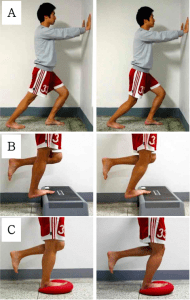Within these hours, I had two online consultations and conducted a face to face running assessment.
Reflective Summary
Muscle tightness is common within the sporting population; it occurs when the muscles ability to contract and relax decreases, causing narrower ranges of motion at the concerned joint (Fatima, Qamar, Hassan & Basharat, 2017). One of my clients had muscular tightness within the calves; shortening of this musculature can cause reduced range of motion at the ankle, specifically in dorsiflexion, which can lead to compensatory movements during walking gait (Lee & Chang, 2019). Because of this research, next time my client comes in, I will assess their dorsiflexion range using the knee to wall test. If there is a deficit in this movement, exercises can be prescribed with the aim of increasing range. A study by Jang, Kim and Jang (2014) wanted to determine the duration of maintained calf muscle flexibility in young adults who had calf muscle tightness after three stretching interventions. There results suggested that eccentric training on either a stable (B) or unstable surface (C) allowed both active and passive dorsiflexion to increase for 30 minutes, which was greater than a static stretching intervention (A). This research can enable sports therapists to select the most appropriate method when trying to increase flexibility of the calf musculature.
What Went Well
Within the online consultations, I asked all the appropriate information in order to get a sound subjective assessment. I was also pleased with how I conducted and analysed the clients running gait by picking out any aspects that could help to optimise the clients running technique.
| Areas for Improvement | Action Plan |
| Become more aware of the normative data for a range of various variables such as running cadence. | Research what the optimal running cadence is per minute. |
| Review other areas that need to be included in a running assessment such as analysing calf stiffness, hip flexor length and single leg stability. | Next time I conduct a running assessment ensure all of these extra areas are included. |
Closing the Loop
Since writing this reflection, I have found an optimal value of 180 steps per minute for running cadence so I am able to compare clients values to this number. I have also had the opportunity to conduct more running specific assessments.
References
Fatima, G., Qamar, M. M., Hassan, J. U., & Basharat, A. (2017). Extended sitting can cause hamstring tightness. Saudi Journal of Sports Medicine, 17(2), 110.
Jang, H. J., Kim, S. Y., & Jang, H. J. (2014). Comparison of the duration of maintained calf muscle flexibility after static stretching, eccentric training on stable surface, and eccentric training on unstable surfaces in young adults with calf muscle tightness. Physical Therapy Korea, 21(2), 57-66.
Lee, J., & Chang, J. (2019). The effect of calf stiffness on gait, foot pressure and balance in adults. The Journal of Korean Physical Therapy, 31(6), 346-350.

